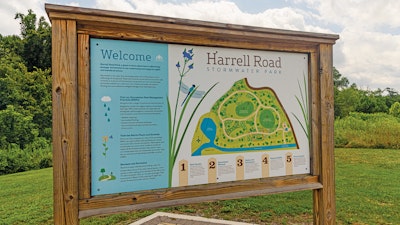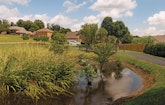
Knox County (Tennessee) Watershed Coordinator Roy Arthur, Compliance Manager Natalie Landry and Flood Plain Manager Eddy Roberts (from left) stand on a bridge overlooking a large bioretention pond they designed. (Photography by Martin Cherry)
Interested in Stormwater?
Get Stormwater articles, news and videos right in your inbox! Sign up now.
Stormwater + Get AlertsKnox County, Tennessee, is verdant, picturesque and a perfect illustration of the problems that arise when stormwater collects in volume. The result is flooding, erosion, destabilized ground and pathogenic threats.
The county’s Stormwater Management Department, however, has the tools to mitigate the worst of these challenges. These include imaginative public awareness campaigns, community outreach activities that spark citizen involvement, scientific analyses and strategies and, of course, rules.
“When we first started ramping up enforcement in 2006 or so, there was pushback,” acknowledges Steve Elliott, director of development services in the county’s Department of Engineering and Public Works. “None of the developers wanted to do it. I would say now that most developers understand the importance of the regulations. There’s a pretty positive attitude out there, much better than at the beginning.”
Colleagues like Natalie Landry, stormwater compliance manager, agree with Elliott’s assessment. “The majority of our regulations have to do with land development. If you disturb the land, that’s where stormwater ordinances come into play. I personally don’t think they are burdensome. They were introduced in 2008, and developers are pretty used to them. There’s not a lot of resistance now.”
Early on, the stormwater team focused on the problem of construction runoff, documenting the need for retention structures and ensuring they were actually built. “We put a lot of energy into that problem area, communicated a lot with developers and that helped. Now we rarely get any complaints about runoff from construction sites,” Elliott says.
Tracy Jones, project manager, focuses on illicit discharges that foul stormwater systems, a critical component in any effort to maintain the integrity of water. “We run into high bacteria counts in less densely populated areas where people aren’t tied into a sanitary sewer system,” says the 20-year veteran of the office. Agriculture and livestock operations also contribute to high bacteria counts in surface waters.
The public supports this comprehensive regimen of regulations, as well as Stormwater Management’s willingness to enforce rules. Landry says citizens “are real quick to report a developer who seems to be in violation. We have done a pretty good job of raising awareness, and people are protective of their streams.”
Floods and sinkholes
There are a lot of streams to protect. Knox County is part of the Great Valley of east Tennessee and contains the headwaters of the Tennessee River. Of the county’s 526 square miles, 17 square miles are water, including some 500 miles of rivers and streams. Many of these waterways originate outside the county but are replenished locally by 50 inches or so of rainfall each year.
Landry has been part of Knox County Stormwater Management for five years and performed similar work for other county and state agencies in addition to private-sector work. Her workday now typically includes planning and implementing initiatives for long-term stormwater issues and responding to residents’ complaints or concerns.
Looking back at the last two years, she can count 514 instances where stormwater staff acted on complaints and requests for assistance. A significant number of those calls were the consequence of rainstorms that hit the county each of the last two Februarys. The storms were not especially ferocious, but they arrived when soil was already saturated.
“A lot of people experienced flooding for the first time ever. It was pretty much all over the county, particularly in areas where there were sinkholes. A lot of times the flooding was from the slow drainage of high water in the sinkholes,” Landry says.
County engineers studied the disastrous flooding, and two corrective roadway projects are scheduled before another February rolls around. In one case, the county will completely realign a dead-end road so that it runs along adjacent higher ground.
The bedeviling sinkholes are a feature of the east Tennessee landscape. Limestone formations beneath the region’s surface tend to erode and create subterranean caverns that eventually collapse, causing surface soils to slump. Some of the resulting depressions in the ground are large and subtle enough to have had homes built in them, though new construction is not permitted in known sinkholes.
In heavy rainfall, runoff will pool in these areas, especially when a sinkhole has no open throat to quickly drain the water. Elliott says solutions include excavating slow-emptying depressions so they can safely accommodate a greater volume of runoff or installing a pump system to more rapidly empty a sinkhole.
The county has a 255-mile network of stormwater pipe as part of its runoff infrastructure. Most of the pipe is in fair condition, according to Jones. Any storm-damaged pipe or pipe segments that residents complain about are fixed. While there is an ongoing replacement regimen for structures 4 feet in diameter and larger, unless a pipe poses a threat to public health, it’s generally deemed good to go.
Good examples
The work of Knox County Stormwater Management isn’t all keeping a wary eye on developers and pipes and cleaning up after flood events. Landry says mitigation projects are going on all the time under the auspices of the county’s Environmental Stewardship Program. Begun 20 years ago, the cost-share program has completed more than 200 projects to date, each designed to help a property owner restore land and prevent future damage.
In each case, the fix is through green stormwater infrastructure, including plantings and nature-friendly engineering. Each project is designed by stormwater management experts and approved by the property owner. If dirt must be moved, bids are submitted by two approved landscape companies and the project owner selects a winning bid. The owner foots 40% of the project cost and Knox County covers the rest.
The projects include erosion-control work that turns gullies into grassy swales. Sometimes it means collapsing stream shoulders are gently banked and stabilized with riparian plants. A major restoration of Beaver Creek is planned, a tributary that helped swell floodwaters in recent Februarys. Other mitigation efforts involve wetlands protection, rain gardens and permeable paver installations.
Landry cites work at Circle Lake Park as a good example of what can be accomplished. There, a large rain garden was installed with engineered soil and plantings to slow and absorb runoff. Permeable pavers were laid in the parking lot so that rainwater can seep through. The enhancements turned the park into a real neighborhood amenity, Landry says.
In the Cedar Crossing condominium sub- division, stormwater workers and volunteers installed nine rain gardens, created a large bioretention area and laid permeable pavers at a public entrance patio. Landry says the subdivision had experienced “pretty intense flooding problems. People love it now.” AmeriCorps workers, a labor source that Stormwater Management regularly employs, helped with that project.
The county is also showcasing some demonstration projects on public grounds including the Harrell Road Stormwater Park that was completed three years ago. The park has two wetland ponds that absorb neighborhood runoff, a rain garden and permeable pavers. The project cost $450,000, with $350,000 of that coming from two statewide grants. The rest was covered by individual donations, small grants and county funds.
All of these projects could appear on the surface as beautification projects, but the purpose of these engineered improvements is to diminish the loss of topsoil, reduce flooding and minimize stormwater pollution.
“Sediment and pathogens are the primary pollutants of concern for Knox County surface water,” Landry says. Moving sediment muddies water, thereby lessening the survivability of aquatic life, and shallowing out streams downstream so they flood more easily. Toxic materials also migrate with loosened soil. “Pathogens from runoff, failing septic systems and overflowing sewer systems create a human health threat.”
Urban and suburban areas pollute the most, of course, but septic tanks and rural Knox County’s agricultural nature can also contribute to the problem.
Outreach programs
Knox County is practically deluged with stormwater management projects. Some are the private-public partnerships already mentioned, while others fall into the category of mitigation education. These are ambitious programs that promote waterways by giving residents a chance to get their hands wet.
The office’s educational outreach sometimes partners with the Knox area Water Quality Forum, a consortium of communities, businesses, utilities and nonprofit groups. Programs include Kids in the Creek and Families in the Creek. The former outing is an all-day activity held near a school. It was inaugurated with one school in the system but has been expanded to middle and elementary school children on several campuses.
In each case, up to 30 students rotate through four stations, assisted by AmeriCorps personnel. They capture and identify types of fish, collect and sort creek-bottom insects, perform chemistry examinations such as pH tests and, in general, evaluate the environmental condition of a waterway.
Stormwater staff members also partner with University of Tennessee, Knoxville professionals to sponsor Tennessee Smart Yards workshops in which experts teach nine principles of sustainable yard creation and maintenance.
The county’s Adopt-A-Stream program was one of the first in eastern Tennessee. Adopting organizations are asked to wade the water or walk the banks of a waterway twice a year to clear away debris. The county has 55 named streams. So far, eight of them are adopted.
And then there are murals. The first one was created three years ago along the Ten Mile Creek Greenway. The greenway passes through a pedestrian tunnel beneath a roadway. At the west exit to the tunnel, a colorful mural adorns wings of the tunnel’s concrete infrastructure. Depicted are the fish, fowl and flora found along the creek. The work was commissioned by the Stormwater Management office and painted by a local artist. “It’s pretty special,” Landry says.
A second mural, this time a mosaic tile creation, was created at a senior center near the county’s Sportspark. It depicts a healthy headwaters ecosystem. Residents helped create tiles in a series of workshops and then were invited to help install them. A grant and private donations funded it.
Diligent monitoring
As the Clean Water Act has evolved over the years, it has come to place greater emphasis on natural drainage options and less on concrete solutions. There is still plenty of the latter in Knox County — 2,245 culverts, for example — but the comprehensive approach pays more attention to water quality. State and local regulations buttress it.
In addition, Knox County participates in the National Flood Insurance Program. In exchange for ordinances that restrict new construction in flood plains, subsidized flood insurance is made available to local homeowners. More regulations, but more protection — the trade-off means more work for the Stormwater Management team.
The county enhances the insurance angle by voluntarily having its flood management policies rated by the Federal Emergency Management Agency. Good ratings lower the flood insurance premiums. If stormwater people stay ahead of the rapid development occurring in some of the watersheds, it all works out. “We’re diligent about monitoring it,” Landry says.
“We’re experiencing fast growth in some areas, but we have a robust stormwater program and a professional inspection program. I feel pretty good about things.” F









